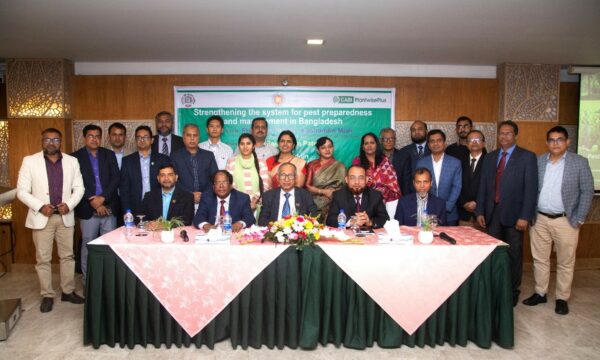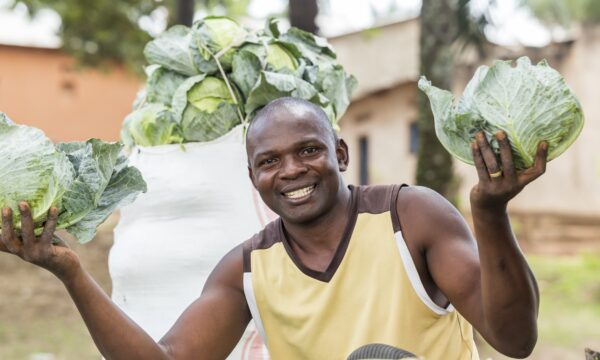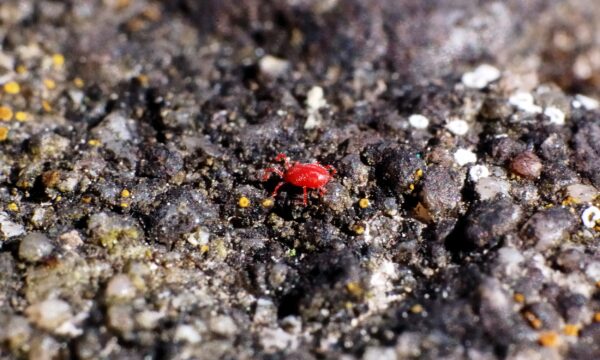
Pustules of the potato deforming rust, Aecidium cantense, on an African eggplant leaf © Fen Beed, CGIAR
In 2011, CABI scientists helped to discover new occurrences of disease-causing phytoplasmas and fungi in Africa, Asia and Oceania. Our scientists, based in Egham in southeast England, provide the Plantwise diagnostic service free of charge to developing countries to support the plant clinics, which give advice to farmers with plant health problems. They work in collaboration with scientists from other institutions around the world to diagnose diseases that can’t be identified in the country that the diseases are found.
As farmers monitor their crops for pests and diseases, new discoveries are being made all the time. New species of pest are found, known pests pop up in a new place or find homes on new plant species. Increased globalisation has facilitated the spread of many pests; more complex trade and travel networks have led to more opportunities for pests to hitch a ride to a new place. Changes in climate can also change the suitability of regions to pests, leading to a spread to locations not previously threatened. When it has been confirmed that a pest has been found in a new place or on a new plant host, our scientists publish their report in a peer-reviewed journal such as New Disease Reports to communicate their findings to the wider scientific community. The following records are those co-authored by CABI scientists in 2011.
There are two new records of plant fungal diseases in the country of Benin in West Africa:
-
First report of potato deforming rust on African eggplant in Africa.
The local name for African eggplant (Solanum macrocarpon) in West Africa is ‘gboman’. Both the fruits and leaves are eaten. Potato deforming (or Peruvian) rust (Aecidium cantense) is known to affect other members of the Solanaceae family, including tomatoes and potatoes. However, it was previously only thought to occur in South America. As African eggplant is widely cultivated in Africa, the discovery of this fungus on the continent could have economic implications for growers.
-
First report of anthracnose caused by Glomerella cingulata on onion in Benin.
A disease has been affecting onion (Allium cepa) crops in southern Benin since 1995. It was not until 2004 that samples of the fungus were tested and it was found to be Colletotrichum gloeosporioides, or as it is now known, Glomerella cingulata (common name: anthracnose). This fungus attacks a wide range of crop species and is found on every continent except Antarctica. It is already known to occur in West Africa and to be a disease of onions but this is the first time that it has been found on this onion species in Benin.
There are also two new records of phytoplasmas affecting crops:
-
First report of a phytoplasma identified in coconut palms with lethal yellowing-like symptoms in Papua New Guinea.
Coconut (Cocos nucifera) is an important crop in Papua New Guinea with exports of coconut products bringing in US$70 million per year. Palm lethal yellowing by phytoplasma has had devastating effects on coconut crops in Florida, southern Mexico and Jamaica, causing losses of up to 80% of palms. This is the first time that a lethal yellowing-like disease has been reported to be present in coconut palms in Oceania. Already 5000 trees in Madang Province, Papua New Guinea have been lost to this disease. The only solution reported to be successful in the long term is to grow cultivars with genetic resistance to this phytoplasma.
-
First report of ‘Candidatus Phytoplasma trifolii’ (group 16SrVI) infecting sweet leaf.
Sauropus androgynus, commonly known as sweet leaf or star gooseberry, is grown as a leaf vegetable in southeast Asia. The phytoplasma ‘Candidatus Phytoplasma trifolii’ was found on sweet leaf in Sabah in Malaysian Borneo. It causes “little leaf” in which the spacing between leaves on the stem is smaller, and the leaves themselves are smaller, giving the characteristic appearance. Phytoplasmas from the same group (group 16SrVI) have been detected on other herbaceous perennial plants but not on sweet leaf. As this is the first global record of this kind of phytoplasma on sweet leaf, we do not yet know the extent of this disease and whether it will have a significant effect on the crop harvest in southeast Asia.
Read the published disease reports:
Beed F, Hotegni Houessou JH, Kelly P, Ezin V, 2011. First report of Aecidium cantense (potato deforming rust) on Solanum macrocarpon (African eggplant) in Benin.. New Disease Reports 23, 12. [http://dx.doi.org/10.5197/j.2044-0588.2011.023.012]
Kelly PL, Reeder R, Kokoa P, Arocha Y, Nixon T, Fox A, 2011. First report of a phytoplasma identified in coconut palms (Cocos nucifera) with lethal yellowing-like symptoms in Papua New Guinea. New Disease Reports 23, 9. [http://dx.doi.org/10.5197/j.2044-0588.2011.023.009]
Sikirou R, Beed F, Hotègni J, Winter S, Assogba-Komlan F, Reeder R, Miller SA, 2011. First report of anthracnose caused by Colletotrichum gloeosporioides on onion (Allium cepa) in Benin. New Disease Reports 23, 7. [http://dx.doi.org/10.5197/j.2044-0588.2011.023.007]
Taylor P, Arocha-Rosete Y, Scott J, 2011. First report of ‘Candidatus Phytoplasma trifolii’ (group 16SrVI) infecting Sauropus androgynus. New Disease Reports 24, 23. [http://dx.doi.org/10.5197/j.2044-0588.2011.024.023]
Related News & Blogs
Common Papaya Disorders: A Comprehensive Guide
Papaya, also commonly known as the papaw or pawpaw, is a large tropical fruit-producing plant originating from Central America. Market demand for tropical fruits has steadily grown, and consequently, the papaya has become an important agricultural expo…
3 April 2024





